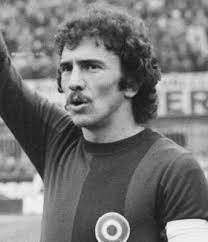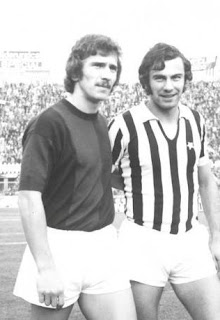Bergamo institution started by students of local high school
The football club now known as Atalanta Bergamasca Calcio - generally known as Atalanta - was founded on this day in 1907 in the Lombardy city of Bergamo.
An historic picture of the Atalanta team that
competed in the 1913-14 season
The club was the idea of a group of students from the Liceo Classico Paolo Sarpi, one of the city’s oldest and most prestigious high schools.
They gave it the rather long-winded name of the Società Bergamasca di Ginnastica e Sports Atletici - the Bergamasca Society of Gymnastics and Athletic Sports - to which they attached the name Atalanta after the Greek mythological heroine famed for her running prowess.
For the first seven years of its life, the new club had no home and played friendly matches on whatever open space was available, but in 1914 found a home ground in Via Maglio del Lotto, adjoining the railway line just outside Bergamo station.
The ground had a small grandstand housing 1,000 spectators. It is said that the drivers of trains approaching the station on match days would slow down in order to enjoy a few moments of the action.
 |
| The club badge depicts Greek heroine Atalanta |
When the club was reconstituted before the start of the 2019-20 season, they established a new home, named the Clementina Stadium, on the site of a former racecourse to the southeast of the city centre.
By that point, club members were eager to join the Italian Football Federation (FIGC) and compete in their league but Bergamo had another team with similar ambitions, called Bergamasca, which had evolved from a club started by Swiss emigrants in 1904.
The FIGC would allow only one team from Bergamo to compete in their Prima Categoria, as their first division was then called. To decide which of them would represent the city, in 1919 a play-off was arranged, which Atalanta won 2-0.
In the event, the two clubs agreed to merge in 1920, forming a new club which at first was called Atalanta Bergamasca di Ginnastica e Scherma 1907 - scherma being fencing. It was soon shortened to Atalanta Bergamasca Calcio, which remains its name today.
The club now plays at the Gewiss Stadium on Viale Giulio Cesare in the northeast of the city, a short walk from the centre of the Città Bassa - Bergamo’s lower city - and visible in the panoramic view available from vantage points on the eastern side of the mediaeval Città Alta, the elevated old part of the city.
 |
| Atalanta BC play their home games at the Gewiss Stadium in Bergamo's Città Bassa |
After the Fascist regime was overthrown in World War Two, the ground was renamed Stadio Communale and gradually expanded to allow more than 40,000 spectators to attend matches. It became the Stadio Atleti Azzurri d'Italia in 1994 and in 2019 adopted the Gewiss name after the club signed a sponsorship deal with the Swiss electronics company.
At the same time as Atalanta moved into the ground in 1928, the Italian championship was restructured with the top division renamed Serie A, as it is today.
Atalanta were initially placed in Serie B but within a decade had been promoted to Serie A.
Nicknamed variously La Dea (The Goddess), Glo Orobici (after the Orobic or Bergamo Alps) or I Nerazzurri (the Black and Blues), Atalanta have never won the Serie A, yet have the proud record of having spent 62 seasons in the top division, 28 in Serie B and only one in Serie B, which is the best record of any team not based in a regional capital.
The current team, managed since 2016 by Gian Piero Gasperini, are enjoying one of the most successful spells in the club’s history, having qualified for the Champions League three seasons in a row and twice reached the final of the Coppa Italia.
Travel tip:
The imposing walls around Bergamo's Città
Alta go back to the time of the Renaissance
Bergamo, the fourth largest city in Lombardy, has an upper and lower town that are separated by impressive fortifications. The magical upper town - the Città Alta - has gems of mediaeval and Renaissance architecture surrounded by the impressive 16th century walls, which were built by the Venetians, of which Bergamo was a dominion at the time. Outside the walls, the elegant Città Bassa, which grew up on the plain below, has some buildings that date back to the 15th century as well as imposing architecture added in the 19th and 20th centuries. While the Città Alta is the draw for many tourists, the lower town also has art galleries, churches and theatres and a wealth of good restaurants and smart shops to enjoy.
Travel tip:
The neoclassical facade of the Liceo
Classico Paolo Sarpi in Bergamo
The Liceo Classico Paolo Sarpi, the high school whose students started the club now known as Atalanta BC, is an historic institution in Piazza Rosate in Bergamo’s Città Alta, opposite the rear entrance of the city’s cathedral. Identifiable by its neoclassical facade designed by Ferdinando Crivelli, the Liceo has its roots in the first public school of Grammar, Humanities, and Rhetorics established by the Republic of Venice in 1506 under the name of Accademia della Misericordia. It was renamed after Paolo Sarpi, a Venetian polymath, in 1803, by Napoleonic decree. The building that houses the modern school was built between 1845 and 1852 under the auspices of the Austrian Government, when it was known as Regio Liceo. In 1860, the academy contributed to the Italian Unification with 70 students joining Garibaldi's Expedition of the Thousand, aimed at annexing the Kingdom of the Two Sicilies to the embryonic Kingdom of Italy. Today it is one of Italy’s leading elite academies, with 100 to 120 students graduating every year and a curriculum based in classical subjects such as Greek, Latin, Philosophy and History.
Also on this day:
1473: The birth of Renaissance sculptor Bartolommeo Bandinelli
1797: Venice loses its independence
1810: The birth of operatic tenor Giovanni Matteo Mario

















